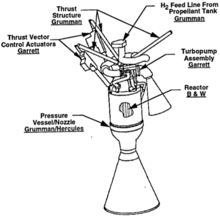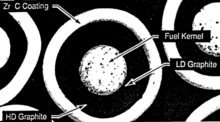Project Timberwind
Project Timberwind aimed to develop nuclear thermal rockets. Initial funding by the Strategic Defense Initiative ("Star Wars") from 1987 through 1991 totaled $139 million (then-year).[2] The proposed rocket was later expanded into a larger design after the project was transferred to the Air Force Space Nuclear Thermal Propulsion (SNTP) program and underwent an audit in 1992 due to concerns raised by Steven Aftergood.[2] This special access program provided the motivation for starting the FAS Government Secrecy project. Convicted felon Stewart Nozette was found to be on the master access list for the TIMBER WIND project.[3]
Advances in high-temperature metals, computer modelling and nuclear engineering in general resulted in dramatically improved performance. Whereas the NERVA engine was projected to weigh about 6803 kg, the final STNP offered just over 1/3 the thrust from an engine of only 1650 kg, while further improving the specific impulse to 930 to 1000 seconds.
Timberwind Specifications
Timberwind 45
- Diameter: 13.94 ft (4.25 m)
- Vacuum thrust: 99208 lbf (441.3 kN)
- Sea level thrust: 88305 lbf (392.8 kN)
- Vacuum specific impulse: 1000 s
- Sea level specific impulse: 890 s
- Engine mass: 3300 lb (1500 kg)
- Thrust to Weight Ratio: 30
- Burn time: 449 s
- Propellants: Nuclear/LH2
Timberwind 75
- Diameter: 5.67 ft (2.03 m)
- Vacuum thrust: 165347 lbf (735.5 kN)
- Sea level thrust: 147160 lbf (654.6 kN)
- Vacuum specific impulse: 1000 s
- Sea level specific impulse: 890 s
- Engine mass: 5500 lb (2500 kg)
- Thrust to Weight Ratio: 30
- Burn time: 357 s
- Propellants: Nuclear/LH2
Timberwind 250
- Diameter: 8.70 m (28.50 ft).
- Vacuum thrust: 2,451.6 kN (551,142 lbf).
- Sea level thrust: 1,912.300 kN (429,902 lbf)
- Vacuum specific impulse: 1,000 s.
- Sea level specific impulse: 780 s.
- Engine mass: 8,300 kg (18,200 lb).
- Thrust to Weight Ratio: 30
- Burn time: 493 s
- Propellants: Nuclear/LH2
Space Nuclear Thermal Propulsion Program







In contrast to the TIMBER WIND project, the Space Nuclear Thermal Propulsion (SNTP) program was intended to develop upper-stages for space-lift which would not operate within the Earth's atmosphere. SNTP failed to achieve its objective of flight testing a nuclear thermal upper-stage, and was terminated in January 1994.[4] The program involved coordinating efforts across the Department of Defense, the Department of Energy, and their contractors from operating sites across the U.S. A major accomplishment of the program was to coordinate Environmental Protection Agency approvals for ground testing at two possible sites.[5]
| Name | Location | Responsibilities |
|---|---|---|
| Brookhaven National Laboratory | Upton, NY | Reactor materials and components testing; thermal-hydraulic, and neutronic analysis; reactor design studies[1] |
| Babcock & Wilcox | Lynchburg, VA | Reactor design testing, fabrication and assembly |
| Sandia National Labs | Albuquerque, NM | Nuclear safety, nuclear instrumentation and operation, reactor control system modeling, nuclear testing |
| Aerojet Propulsion Division | Sacramento, CA | Fuel element alternate materials development |
| Hercules Aerospace Corporation | Magna, UT | Design and fabrication of engine lower structure and nozzle |
| Garrett Fluid Systems Division | Tempe, AZ and San Tan, AZ | Design and fabrication of attitude control system, propellant flow control system and turbopump assembly |
| AiResearch Los Angeles Division of Allied Signal | Torrance, CA | Turbine wheel testing |
| Grumman Space Electronics Division | Bethpage, NY | Vehicle design and fabrication, systems integration |
| Raytheon Services Nevada | Las Vegas, NV | Facility and Coolant Supply System (CSS) engineering, facility construction management |
| Reynolds Electrical and Engineering Company, Inc | Las Vegas, NV | Facility construction |
| Fluor-Daniel, Inc. | Irvine, CA | Effluent Treatment System (ETS) engineering |
| Sandia National Labs | Saddle Mountain Test Site or QUEST or LOFT Sites | Test site preparation, planning and performance of engine ground tests, nuclear component testing |
| [REDACTED] | Washington, DC | Program management |
| DoE Headquarters | Washington, DC | Program management, nuclear safety assurance |
| DoE Nevada Test Site | Las Vegas, NV | Ground testing |
| DoE Idaho National Engineering Lab | Idaho Falls, ID | Ground testing |
| U.S. Air Force Phillips Lab | Albuquerque, NM | Program management |
| U.S. Army Corps of Engineers | Huntsville, AL | ETS engineering management |
| Los Alamos National Laboratory | Los Alamos, NM | Fuels and materials testing |
| Marshall Space Flight Center (NASA) | Huntsville, AL | Material and component simulation/testing |
| Western Test Range/Western Space & Missile Center (USAF) | Vandenberg AFB, CA | Program review |
| Arnold Engineering Development Center | Manchester, TN | Hydrogen flow testing |
| UNC Manufacturing Company | Uncasville, CT | Materials manufacturing |
| Grumman Corporation - Calverton Facility | Long Island, NY | Hydrogen testing |
The planned ground test facilities were estimated to cost $400M of additional funding to complete in 1992.[6] Fewer than 50 sub-scale tests were planned over three to four years, followed by facility expansions to accommodate five to 25 1000 second full-scale tests of a 2000MW engine.[5]
Initially, PIPET [Particle Bed Reactor Integral Performance Element Tester] was envisioned as a small, low-cost, SNTP-specific experiment for testing and qualifying PBR fuel and fuel elements. The demands by other agencies, DOE and NASA, resulted in a national test facility for NTP fuel, fuel elements, and engines. Its size out grew the SNTP Program's ability to secure the funds for such a large construction project. Though the demands were placed upon the SNTP Program to expand the facility's scope and the SNTP Program's management tried to coordinate tri-agency, DoD-DOE-NASA, support and funding, adequate funding support for the national ground test facility was not obtained.
The program had technical achievements as well, such as developing high-strength fibers, and carbide coatings for Carbon-Carbon composites. The hot-section design evolved to use all Carbon-Carbon to maximize turbine inlet temperature and minimize weight. Carbon-Carbon has much lower nuclear heating than other candidate materials, so thermal stresses were minimized as well. Prototype turbine components employing a 2-D polar reinforcement weave were fabricated for use in the corrosive, high-temperature hydrogen environment found in the proposed particle bed reactor (PBR)-powered engine.[4] The particle bed reactor concept required significant radiation shielding, not only for the payload, electronics and structure of the vehicle, but also to prevent unacceptable boil-off of the cryogenic propellant. A propellant-cooled, composite shield of Tungsten, which attenuates gamma rays and absorbs thermal neutrons, and Lithium Hydride, which has a large scattering cross section for fast and thermal neutrons was found to perform well with low mass compared to older Boron Aluminum Titanium Hydride (BATH) shields.[7]
Sandia National Labs was responsible for qualification of the coated particle fuel for use in the SNTP nuclear thermal propulsion concept.[6]
| Pro | Con | |
|---|---|---|
| Bleed Cycle | 1. Lowest system complexity, 2. Minimum reactor internal plumbing & manifolding 3. Development of reactor and balance of plant (BOP) is uncoupled 4. Fast startup easily achieved | Development of high temp turbine and feed lines required |
| Partial Flow Expander Cycle | 1. State of the art turbine technology can be used 2. Higher Isp (~0.5%) | 1. Coupled reactor and BOP development increases programmatic risk 2. Dedicated fuel elements to supply energy to drive the turbine are of unique design and require additional development |
References
- ↑ 1.0 1.1 Ludewig, H. (1996), "Design of particle bed reactors for the space nuclear thermal propulsion program", Progress in Nuclear Energy 30 (1)
- ↑ 2.0 2.1 Lieberman, Robert (December 1992). "Audit Report on the TIMBER WIND Special Access Program". Department of Defense. Retrieved 28 July 2012.
- ↑ Aftergood, Steven (October 2009). "Nozette and Nuclear Rocketry". Federation of American Scientists. Retrieved 28 July 2012.
- ↑ 4.0 4.1 4.2 Haslett, R.A. (1995), Space Nuclear Thermal Propulsion Program Final Report
- ↑ 5.0 5.1 5.2 "Final Environmental Impact Statement (EIS) for the Space Nuclear Thermal Propulsion (SNTP) Program". U.S. Defense Technical Information Center. September 1991. Retrieved 7 Aug 2012.
- ↑ 6.0 6.1 Kingsbury, Nancy (October 1992). "Space Nuclear Propulsion: History, Cost, and Status of Programs". U.S. Government Accountability Office. Retrieved 4 Aug 2012.
- ↑ Gruneisen, S.J. (1991), Shielding Requirements for Particle Bed Propulsion Systems
External links
- Encyclopedia Astronautica link about the Timberwind 45
- Encyclopedia Astronautica link about the Timberwind 75
- Encyclopedia Astronautica link about the Timberwind 250
- Space Nuclear Thermal Propulsion Program Final Report